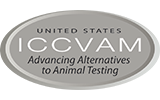Predictive Modeling of Developmental Toxicity with Human Pluripotent Stem Cells
EPA, FDA, and NICEATM scientists and collaborators applied IVIVE to evaluate the impact of pharmacokinetic models on predicting relevant external exposure from in vitro developmental toxicity potential concentrations derived from an in vitro human iPSC-based assay. Previous work showed that the devTOX quickPredict assay ranked ranked the developmental toxicity potential of valproate analogues in a manner that was consistent with observed developmental toxicity potency in vivo. The IVIVE analysis in this project estimated equivalent administered doses that would result in maternal and fetal blood concentrations equivalent to the developmental toxicity potential and cytotoxic in vitro concentrations (Chang et al. 2022). The estimated equivalent administered doses were compared to published lowest effect levels from in vivo developmental toxicity studies. Preliminary results of this analysis showed that equivalent administered doses for the valproate analogues based on different pharmacokinetic and PBPK models were quantitatively similar to in vivo data from both rats and humans, where available. The impact of in vitro kinetics on equivalent administered dose estimates was chemical-dependent. Equivalent administered doses from this study were within the range of predicted doses from other in vitro and model organism data. This suggested that the devTOX quickPredict assay and IVIVE approaches can quantitatively assess a chemical’s developmental toxicity potential.



